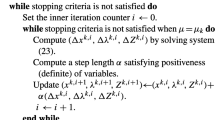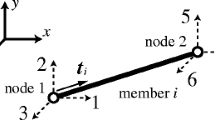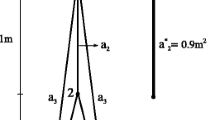Abstract
The paper deals with the effect of dimensional imperfections of truss members on the minimum weight design of a structure. It is assumed that for each element its imperfections cannot exceed given a priori maximum values, called tolerances. The incorporation of the considered imperfections into the design is achieved by diminishing the limit values of state functions by the product of assumed imperfections and appropriate sensitivities. Therefore, the given method allows the introduction of tolerances into the design in a relatively simple way. In the submitted paper both members’ cross-section and length imperfections are discussed. The paper is illustrated with several design examples, considering cases with multiple loading conditions and buckling analysis. The achieved optimum solutions for designs with admissible tolerances show significant differences in structural weight and material distribution compared to ideal structures (i.e. having nominal dimensions). The calculations for designs with buckling analysis also reveal changes in material distribution compared to the designs without buckling constraints.
Similar content being viewed by others
References
Bauer, J.; Gutkowski, W. 1993: Structural optimization with sensitivity constraints and multiloading conditions. In: Herskovits, J. (ed.) Proc. Conference on Structural Optimization’93 (held in Rio de Janeiro, Brasil), pp. 65–71
Ben-Haim, Y.; Elishakoff, E. 1990: Convex models of uncertainty in applied mechanics. Amsterdam: Elsevier
Gutkowski, W.; Bauer, J. 1994: Structural optimization with sensitivity constraints: statics. Comput Struct52, 121–125
Gutkowski, W.; Bauer, J. 1999: Manufacturing tolerance incorporated in minimum weight design of trusses. Eng Optim31, 393–403
Jensen, H.A.; Sepulveda, A.E. 1997: Fuzzy set optimization of complex systems using approximation concepts. In: Proc. 5-th PACAM (held in San Juan, Perto Rico), Vol. 5, pp. 345–348
Kristinsdottir, B.P.; Zabinsky, Z.B.; Tuttle, M.E.; Csendes, T. 1996: Incorporating manufacturing tolerances in near-optimal design of composite structures. Eng Optim26, 1–23
Lee, K.H.; Park, G.J. 2001: Robust optimization considering tolerances of design variables. Comput Struct79, 77–86
Ringertz, U.T. 1988: On methods for discrete structural optimization. Eng Optim13, 47–64
Venter, G.; Haftka, R.T. 1999: Using response surface approximations in fuzzy set based design optimization. Struct Optim18, 218–227
Yu, J.C.; Ishii, K. 1998: Design optimization for robustness using factorial models. Eng Optim30, 203–225
Author information
Authors and Affiliations
Corresponding author
Rights and permissions
About this article
Cite this article
Gutkowski, W., Latalski, J. Structural optimization with member dimensional imperfections. Struct Multidisc Optim 30, 1–10 (2005). https://doi.org/10.1007/s00158-004-0383-2
Received:
Published:
Issue Date:
DOI: https://doi.org/10.1007/s00158-004-0383-2




